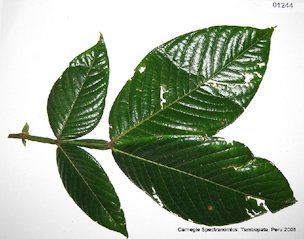Inga macrophylla
Family: Leguminosae subfamily Mimosoideae
Botanical: Inga macrophylla Kunt.
Synonym: Inga quadrangularis Ducke
Vernacular: ingá-peuá, ingá-peba (Brazil, Amazonia), pacai amarillố (Bolivia).
Ecology and Distribution
Inga macrophylla
occurs in the relatively low profile, secondary growth known as
"capoeira" and "capoeirinha", preferring non-flooded terra firma and
grows well infertile clay soils with some organic matter.
Its
distribution pattern within the Amazon basin suggests that it is not
particularly sensitive to the variety of climates to be found in the
region, although it does appear to prefer low altitudes not exceeding
250 m.
Although frequent, the tree is not abundant and is
encountered only as dispersed, isolated individuals, even when
cultivated for shade or fruit production.
Ingá-peuá is native
to the Amazon Basin and is distributed throughout the entire region,
including Brazil, Bolivia, Peru and Venezuela.
Related species: the genus Inga includes some 200 species in tropical America, with 90 species in Amazonia (Ducke,1949).
The majority of the species produce edible fruits, but only a few have a pulp thick enough to be of economic interest.
In addition to the species treated here, only four others deserve mention: I. edulis Mart., "Ingá-cipo"; I. cinnamomea Benth., "Ingá-açu"; I. capitata Desv. "Ingá costela"; I. ruiziana G. Don, "Ingá peba".
Description
A small tree to 5m high, with a wide, low crown; root system unknown.
Leaves
alternate, 1-pinnate; stipules cordate, c. 12 mm long, deciduous,
rachis, including petiole 9 cm or more long, broadly winged between the
leaflets and with a raised, cup-shaped or cylindrical nectarial gland
on the upper side between the junction of each pair of leaflets;
leaflets 2-3 (-4) pairs, broadly elliptic, 12-18 cm long, 6-9 cm wide,
apex acuminate or sometimes retuse, base sub-cordate, margins entire,
glabrous.
Inflorescence axillary or terminal, on a short peduncle up to 6 cm long; flowers subsessile, in a short, bracteate raceme.
Calyx
narrowly cylindrical, 15-25mm long, with 5 deltoid teeth, glabrous or
sparsely hairy; corolla white or yellowish, narrowly cylindrical, 20-40
mm long, densely hairy outside, with 5 lobes; stamens numerous, fused
into a tube below, delicate; ovary elongate, stipitate, with 8-10
ovules, style long, filamentous.
Fruit a stout, woody pod,
rectangular in cross-section, straight or sometimes arcuate, up to 45
cm long, 4-5 cm wide, yellow, with 8-10 seed 3 cm long enveloped in a
white, slightly fibrous pulp. Flowering July to September and
sporadically during the fruiting season; fruiting January to April.
Main Uses
The
only edible part of the fruit is the pulp, which is white and slightly
fibrous and surrounds the seed. The seed and surrounding pulp are
approximately equal in weight. The pulp is simply sweet with no aroma
worthy to mention. It is consumed exclusively in natura.
The tree is very suitable for shade
Method of Collection of the Edible Part
The fruits only fall from the tree long after they are ripe and are unsuitable for consumption.
The pods should be collected by hand using a cutting instrument.
The fruits are ready to be collected when they are thick and the endocarp turns yellow.
There is no precise information on yields but random observations of production fluctuate around 100 to 150 fruits per harvest.
Nutritional Value
No information is available.
Cultivation and Propagation Methods
There are no technical reports on the cultivation of ingá-peua, but it is known that the plant propagates spontaneously from seeds and that monkeys are the principal dispersers.
The
seeds of well-matured fruits will germinate in 4 to 5 days.The
seedlings grow rapidly if planted in soil with a significant amount of
organic matter. The tree can begin to flower and fruit at 3 to 4 years
of age.
Potential Economic Importance
Like the other species of Inga, principally I. edulis and I. cinnamomea,
which are abundant in local markets, the ingá-peua could very well
represent another option in the array of fruits offered to consumers.
The
plant's voluminous fruit with a large proportion of edible pulp rivals
that of the other two species. All that is required is the selection of
more productive varieties and the use of improved strains.The rest is
easy, since the tree is a vigorous wild plant which does not require
expensive culture techniques.
 | |
Fig. 1 |
Back to
Inga Species page
|
